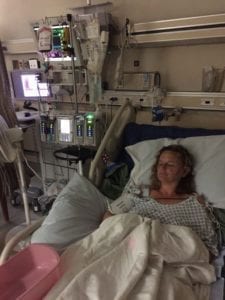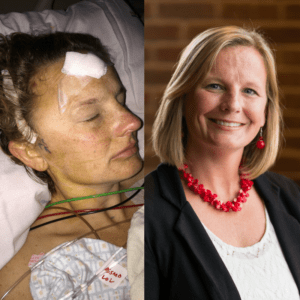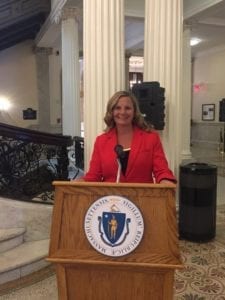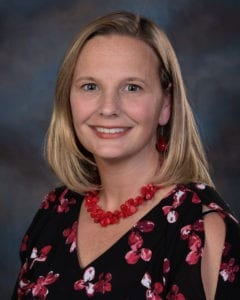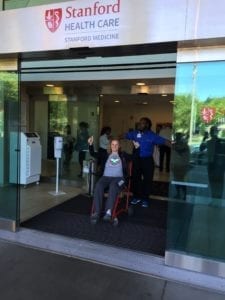
Lisa’s two direct and indirect bypass surgeries were successful. She now had seven times more blood flow to her brain than she had before surgery. She felt very fortunate.
The recovery, however, was anything but easy. Lisa temporarily lost some speech. She would try to say something but the right words wouldn’t come out.
When she came home to her children she tried to read aloud to her son and found that she couldn’t. For a month, her kindergartner had to read to her.
She dealt with anxiety, depression, and PTSD. She would wake up in a panic with thoughts of what she had been through, and what could have happened.
After three months she was physically healed and had regained her speech. She was able to walk and complete everyday tasks, but it would be a full year until she felt she had recovered emotionally.
Her head wasn’t shaved for the surgeries, rather the surgeons simply parted her hair. She reflected how strange it was, to have undergone so much, physically and emotionally, but to get on the plane to go home with the eight inch scars on each side of her head covered. To the passerby, she looked fine.
Now, three and a half years post-surgery, Lisa has experienced good results. The doctors at Stanford believe that now that both sides of her brain have been re-vascularized, she will have a normal life expectancy and hopefully no more strokes.
In addition to a daily Aspirin, she takes medication to counteract the side effects that she continues to experience from the treatments she underwent in her twenties.
She continues to go to checkups at Stanford and is grateful that her primary care doctor, who hadn’t heard of Moyamoya Disease when Lisa was diagnosed, is proactive about learning as much as she can about the condition.
Lisa feels fortunate that the Moyamoya community has an active online presence. She’s benefited from the support of others with the condition and has continued her own advocacy work.
She has advocated on federal and state levels and has met other patients in person. She hopes that awareness of Moyamoya Disease increases so that others won’t have such a long diagnostic odyssey.
Lisa herself started a nonprofit, Sisters@Heart, with two other women in her community. One is a heart patient, and the other has a child with a heart defect.
Their organization was established in 2016 and their mission is to fund research, help alleviate families’ financial burdens, and improve the lives of those impacted by heart disease and stroke. They donate to various hospital research programs and also aid local families.
“It’s really neat to be able to take personal experiences and help impact others. While not all of us are in the clear, we have benefited so much from research, technology, and medical care and are really hoping to help other people.” – Lisa
Lisa reflects how the loss of her career impacted her and how angry and sad she had been at the way her unexpected medical condition affected her life. She first learned what advocacy really was in her early twenties. She volunteered in the advocacy office of the Heart Association and participated in their lobby days.
“I remember saying to them ‘you need to have patients telling their stories’, it was a new idea back then. It was mostly doctors, researchers, and donors. I created a luncheon for patients to share their voice. I wanted to meet other survivors and when I would tell a legislator that I had a stroke at 21, they were shocked. I realized we could have voice and that we matter.”- Lisa
She learned she needed to figure out a way to see the positives in her life and she found a passion for helping patients and survivors find
their voices.
“I can not only share my story but inspire others to share theirs to impact policy on a higher level. I’m fortunate to be in the situation I am despite health problems. I love to speak about how to stay positive and live your best life even when it doesn’t go how you want, I’ve had to learn that.” -Lisa
Lisa’s advice to a friend or loved one of someone who was just diagnosed is to listen. She says you can also gently deliver the message that “There will be a light at the end of the tunnel. You have to keep having hope and you will get there.” but she wants it to be understood that immediately following diagnosis, many might not be ready to hear that yet.
“This journey is taken one day at a time.” -Lisa
Her advice to someone who just received their diagnosis is “be your own advocate and fight for yourself. If I didn’t, I might not be here today.” –Lisa
Lisa wishes that she could have told her younger self “It’s okay that life doesn’t turn out how you thought it would. One of my hardest days was when the doctors took me out of work, but today I am living a great life. I have a family and I love and receive so much satisfaction in my role of Mom, volunteer, speaker and patient advocate.”
Lisa has steadfast hopes for the future, picturing a healthy one for herself in which she is able to continue to share her voice and make a difference for other patients.
For her condition as a whole, she hopes an organization does develop and that she can play a part in it. She hopes that research continues, a cure is developed, and that all patients can live a full life. She hopes for a more patient focused world.
“I often look back, because all these experiences have made who I am, and I have been able to create a good life, a positive life, and I want to be able to show others they can have that too. There are silver linings. You can still find the good, despite what life throws at you, and I still have to remind myself of that. There has to be a way to get back up when you’re down.” – Lisa




